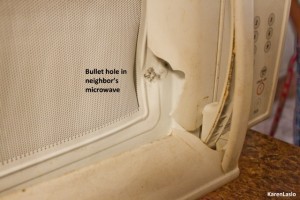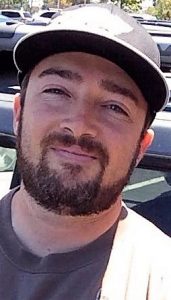by Dave Waddell
news analysis
Chico police officer Alex Fliehr, who fired first and the most in the Desmond Phillips killing, has testified about trying to shoot Tyler Rushing three months later. In the confrontation that killed Rushing, Fliehr also shot a Taser as Rushing lay prone, motionless and unarmed.

Those facts and others – including that Fliehr saw “action” in the Iraq war – have emerged in sworn testimony during depositions for wrongful death lawsuits filed against the city of Chico by the Phillips and Rushing families. The two men were both experiencing mental disorders when shot to death in 2017.
Fliehr’s combat history was left off his resume when Police Chief Mike O’Brien held a news briefing three days after the March 17, 2017, killing of Phillips, a young black man. O’Brien’s purpose was to identify the two inexperienced officers, Fliehr and Jeremy Gagnebin, who together had sprayed the Phillipses’ small living room with 16 shots. Eleven of their hollow-point rounds devastated Phillips’ body. He probably died before he hit the floor — this 25-year-old, who, when killed, was mentally disabled and likely also feeling the effects of being shocked by a police stun gun. No officers were hurt.
As for the rounds that missed, neighbors in an adjoining apartment were fortunate they were out at the time, with police bullets hurling through their living room and putting holes through closeted clothes. Another errant shot barely missed a third officer.
At his briefing, O’Brien informed the news media that Gagnebin (pronounced Gan-a-bin) had received a bachelor’s degree in criminal justice from Sacramento State and a master’s degree from the University of Arkansas in sports management. Fliehr (rhymes with “near”) received a bachelor’s in criminal justice from Chico State, the chief said. Both were trained by the Butte College police academy. Fliehr and Gagnebin’s police-officer experience, combined, totaled just 3 1/2 years at the time they shot Desmond Phillips to the floor while his horrified father yelled for Fliehr to stop.

In retrospect, what is most revealing about O’Brien’s briefing — he declined to take any questions from reporters and announced his department would have no further comment – was what the police chief did not say.
O’Brien withheld from his community the fact that Fliehr had served in combat in Ramadi. Fliehr did not provide a time frame for his military service in his testimony. A Marine for six years who was discharged as a corporal, Fliehr testified he did not shoot his weapon in war.
Fliehr’s testimony was given for a lawsuit brought by the family of Tyler Rushing, who was killed July 23, 2017, three months after Phillips was riddled with bullets. Fliehr and Gagnebin were also at the scene of that shooting, with Fliehr using a Taser on Tyler Rushing in a manner that his father, Scott Rushing of Ventura, called “sadistic.”

“Fliehr was using the Taser to see if Tyler was alive or not, from my point of view,” Scott Rushing said. “A sickening and unconscionable action that has to be a total violation of police training and protocol.”
‘Panic shooting’
In the Phillips killing, Butte County District Attorney Mike Ramsey ruled that Fliehr and Gagnebin acted reasonably and committed no crime. Phillips’ surviving family members’ civil damage claims against the city of Chico were blocked last month by a federal judge, but their attorney is seeking a quick reversal and a trial by jury.
Roger A. Clark of Santee, Calif., a law enforcement expert hired by attorneys for the Phillips family, concluded in a report that Fliehr appeared to fire his gun at Phillips “out of fear,” something law enforcement officers are trained to avoid. Clark, who operates Police Procedures Consultant Inc., worked 27 years for the Los Angeles County Sheriff’s Department, the last 15 as a lieutenant.
“… The gunfire was unreasonable because the officers were never in danger from Desmond to the point they could not have reasonably removed themselves from that danger, and … the excessive shooting demonstrates the officers did not re-assess after their initial shots (which were themselves unreasonable). In my experience, this level of excessive shooting is indicative of a panic shooting [by Fliehr], and consistent with sympathetic and contagious gunfire [by Gagnebin],” says Clark’s report.
Fliehr also shot the prone, motionless Tyler Rushing in the back with a Taser apparently to determine whether he was capable of any resistance – a highly unusual use of a stun gun by a law enforcement officer. And that was after Fliehr testified he had “tried” to shoot his Glock 17 Lugar pistol at the wounded, flailing Rushing, who allegedly was armed at the time only with a Chico PD-issued ballpoint pen, apparently pulled from an officer’s pocket. Taken at his words under oath, Fliehr would have been a shooter in both 2017 Chico PD shootings had other officers not been in the way of a clear shot at Rushing.
CPD highlights its vets
While military service among its officers is something the Chico Police Department normally trumpets, Fliehr’s service provided an optics that O’Brien may have preferred not to bring into focus.

Chico Police Chief Mike O’Brien
O’Brien did not respond to ChicoSol’s request for comment for this article. Fliehr forwarded ChicoSol’s email seeking comment to his union, the Chico Police Officers’ Association. CPOA President Jim Parrott told ChicoSol it was inappropriate for Fliehr to comment because of lawsuits brought by the Phillips and Rushing families.
O’Brien’s omission of Fliehr’s combat history might not have been so glaring had it not occurred in the same year Chico PD was pumping up its employees who are veterans. In a PR production, more than a dozen short videos were posted to YouTube to coincide with Veterans Day in 2017. A voice-over in each says: “To those who have served our country and now serve our community, to our veterans we say ‘thank you.’”
One such video is still prominently displayed on the department’s Facebook page. Each video salutes a Chico officer and provides some basics about his or her branch, service, and, if applicable, combat duty. No such video about Fliehr could be located.
Fliehr fought in the Iraq war, a conflict in which one in five veterans report symptoms of post-traumatic stress disorder or major depression. Fliehr presumably was certified as psychologically fit for duty by Chico PD on at least two occasions: (1) Before he was hired and given a badge and deadly weapons, and (2) before he was cleared to return to duty after shooting at Phillips nine times within four seconds. During a deposition, a lawyer for the city of Chico repeatedly refused to let Fliehr answer questions from Rushing family counsel about the officer’s psychiatric care, if any, after the Phillips killing. Fliehr said he was on paid administrative leave for “four or five weeks.”
First to fire
Soon after Desmond Phillips’ death, Butte County District Attorney Mike Ramsey was asked by a reporter which officer, Fliehr or Gagnebin, fired his pistol first.
“Unknown,” Ramsey said.

If Ramsey and his “seasoned investigators” never learned who first pulled his trigger, they must not have asked the shooters. When questioned in deposition, Gagnebin said Fliehr shot first. Fliehr claimed under oath that he wasn’t aware until after the fact that Gagnebin had fired his pistol, even though Gagnebin shot seven bullets from within spitting distance of Fliehr.
When killed, Phillips was purported to be holding a piece of shattered wood from a door jamb, created when Fliehr kicked open the Phillipses’ front door. Officers had hurriedly decided to bust in after Desmond’s father, David, said his son was trying to stab him with a knife during a frantic 911 call. To their surprise, when the door flew open, Desmond was, in Gagnebin’s words, “butted up against the doorway.”
Officer Jared Cumber, who Tased Phillips, described his demeanor at the doorway as: “He didn’t appear to be paying attention to us. He would just stare at us flatly.” Cumber claimed he yelled “Taser! Taser! Taser!” before shooting Phillips with the stun gun. Clark, the expert hired by Desmond’s family, said Fliehr and Gagnebin “squandered” the opportunity to apprehend Phillips when he was initially felled. Clark’s report also is critical of Cumber for not re-deploying the Taser in some manner after Phillips suddenly stood up.
Fliehr testified in deposition that the first person he was “sequestered” with after shooting Phillips was a representative from CPOA. Fliehr said the same was true of Gagnebin. Parrott, the union president, did not respond when asked via email to confirm or deny Fliehr’s statement that union reps huddled with the shooters prior to them giving statements to criminal investigators.
‘He’s still moving!’
Fliehr’s behavior the night Tyler Rushing was killed makes O’Brien’s omission of the officer’s military background all the more striking.
Here’s what happened to Rushing: He became homeless in Chico after leaving a music festival where his belongings had been stolen, and the night he was killed he had taken refuge in the fenced back patio of a local title company. His mind had gone haywire on this hot July night.
(An autopsy conducted by Ramsey’s medical examiner found only seven nanograms of THC from marijuana in Tyler’s body. A second autopsy paid for by the family found “not a smidgen, not a scintilla” of any drugs in his son’s body, Scott Rushing said.)
First, Tyler was shot in the chest by the 23-year-old, armed-to-the-teeth security guard who Rushing had assaulted and cut on the forearm (nine stitches were needed to sew up the wounds) with the handle of a small glass flower pot. Rushing then retreated and bled out from the severe gunshot wound in a bathroom for roughly 45 minutes while Scott Ruppel, then a Chico police sergeant, tried to talk him out.
He then was attacked and bitten deeply on his calf by a German shepherd police dog. According to Ramsey, Rushing then allegedly “stabbed” Ruppel with the Chico PD ballpoint pen, which was never recovered. Ruppel then shot Rushing twice — first in the front of his neck and, 1 2/3 seconds later, in the back of his neck. Ruppel, whose own neck was scratched in the incident, later testified that he was not hurt by Rushing.
Though more senior officers were on the scene, Fliehr indicated in his testimony that he took command after Ruppel fired twice and exited the bathroom. Fliehr said under oath that he wanted to prevent Rushing from jumping to his feet and stabbing other officers.
Ruppel’s bullets had sent Tyler Rushing to the floor. He lay in his own blood on his stomach with his face slightly to one side. One empty hand was extended out; the other was not visible beneath his chest. To one cop, however, Tyler Rushing was still too dangerous for officers, even while fingering their Glocks, to attempt to put in restraints.
“He’s still moving!” Fliehr shouted, according to a body camera recording discussed at a deposition. “He’s not handcuffed.”
Had Rushing actually been clinging to a strand of life at that point, any chance to save him had slipped away by the time he was shocked by Fliehr’s Taser with 50,000 volts of electricity, cuffed, and dragged out of the bathroom.
DA Ramsey’s report on the killing normalizes Fliehr’s Taser use and de-humanizes Tyler Rushing by referring to him on many occasions as a nameless “subject.”
In truth, there was much more to 34-year-old Rushing than his bizarre Chico odyssey. He was close to his family, had many friends, and operated a window-washing business in Ventura. He loved working at music festivals. Rushing was, based on numerous accounts at his funeral service, an uncommonly selfless man whose mantra of “peace, love and positivity” was genuine.
As if the gunshots, the dog and the Tasering weren’t enough, Rushing would be subjected to one long, last indignity by Butte County law enforcement. Due to bureaucratic negligence, Tyler’s body lay for 10 hours on the floor of the Main Street title company where he died before finally being examined medically and taken to a mortuary.
Fliehr would later say what happened that night was akin to a “horror story.” For doubtless very different reasons, Tyler Rushing’s deeply traumatized family would excruciatingly agree.
Dave Waddell is a former journalism professor and reporter and a contributor to ChicoSol. He is currently working on a book related to law enforcement shootings in Butte County and can be reached at davidlwaddell@gmail.com.

If the Chico police officers involved in the fatal shootings of Breanne Sharpe, Desmond Phillips, and Tyler Rushing had acted like “peace officers” instead of “trigger-happy cops,” precious lives and taxpayer dollars would have been saved.
Yes, Scott – Amen
The District Attorney is as much to blame as the Officers involved in these murders .
Prayers are not enough for losses of this kind.
DA , Officers, Commanders should be held accountable, at a considerable Tax Payer cost, for these murders.
I hope this article serves to get the population of Chico awakened as to the corruption in their law enforcement system. Police, sheriff, and DA offices (and maybe even the state attorneys) need a major house cleaning and somehow justice must be found for the lost lives. So sad!